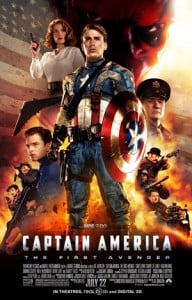Captain America: The First Avenger, directed by Joe Johnston. Written by Christopher Markus and Stephen McFeely. Starring Chris Evans, Hayley Atwell, Hugo Weaving, Sebastian Stan, Tommy Lee Jones, Stanley Tucci, and Samuel Jackson. Released by Paramount Pictures. Rated PG-13 (for intense sequences of sci-fi violence and action). Running time: 124 minutes.

Although shot in vivid color, Paramount studios’ Captain America: The First Avenger embraces a refreshing black-and-white, good versus evil worldview lacking in most of the recent spate of dark, nihilistic superhero films.
The picture occurs mostly in flashback—with a very brief framing story set in the present day—during the early days of America’s involvement in World War Two. Steve Rogers (played by Chris Evans), like most patriotic young men of the day, is itching to enlist and join the fight. However, his motivation is more than patriotism: He does not like bullies and sees the Third Reich as the biggest bully on the planet. Unfortunately, he is too short and underweight to meet the fighting ideal, and finds himself marked “4F” at recruiting station after recruiting station. But although he does not have the physical strength of his friend, strapping U.S. infantryman “Bucky” Barnes (played by Sebastian Stan), he is at least as brave, standing up to bullies with little regard for his personal safety. Soon, the tenacious and brave Rogers comes to the attention of Dr. Erskine (played by Stanley Tucci), who is looking for volunteers to take part in his “Project Rebirth,” an experiment that aims to create an army of U.S. “super soldiers.”
Because of his bravery and strong moral code, Rogers is a perfect choice for Dr. Erskine’s project and becomes America’s first super soldier, thanks to Rebirth Serum. (However, due to an unfortunate turn of events, Rogers remains America’s only super soldier.) After capturing the public’s imagination with a spectacular display of heroics, the newly minted “Captain America” is relegated to life as a propaganda tool for the U.S. government, contributing to the cause of freedom with a two-bit floor show aimed at selling war bonds.
But when Rogers discovers that his old buddy Bucky’s squad has been captured by Nazi super soldier Red Skull (played by Hugo Weaving) and his horde of HYDRA agents, Captain America springs into action.
After a death-defying rescue of Bucky and the others, Captain America and a crack team of allied soldiers called the “Howling Commandos” (consisting of Bucky and some of the other rescued soldiers) embark on a search-and-destroy mission aimed at stopping HYDRA’s nefarious plans to wage a war parallel to the world war. This search ends in the inevitable showdown between the good and evil super soldiers.
Captain America initially transcends its comic book source material, with Rogers choosing and being chosen to become a superhero because of his virtues, rather than as the result of a twist of fate, bizarre accident, or for his physical attributes. However, after Rogers becomes Captain America and takes the battle to the Red Skull, the conflict becomes purely physical, jettisoning any possibility of a battle of wits or will. The action sequences are handled well, exploiting the comic book’s strength in summarizing action in iconic visual tableaus, such as in an attack on a giant battle tank in a ruined European town. But this leaves little time for any sort of character development or adding a third dimension to the plot.
It is unfortunate that so little time is spent building a personal conflict between Captain America and Red Skull. The idea of a parallel war being fought for the Red Skull’s own aims is a fascinating idea that could have led to some interesting plot twists if further developed. And in his World War Two incarnation, Captain America is a rather flat character; he has few, if any, internal conflicts or character flaws. Hopefully next summer’s The Avengers (a trailer for which is included at the end of Captain America) will more fully explore Rogers’ place among the most tragic figures in the Marvel comic book universe.
But the lack of character development is due, no doubt, to the fact that Captain America exists (as did Thor two months earlier) as a lead-up to The Avengers, which will unite the primary stable of Marvel heroes—Iron Man, the Hulk, Thor, Captain America, Nick Fury, and several others we’ve only glimpsed in these other films. Indeed, the film works on its own terms, taking itself seriously enough yet with touches of humor that do not undercut the derring-do.
For the comic book fans in the audience, there are a lot of nice touches: the Howling Commandos, Tony Stark (aka Iron Man)’s Howard Hughes-esque father, a nice nod to Captain America creators artist Jack Kirby and writer Joe Simon, and an homage to Kirby’s over-the-top visual style courtesy of production designer Rick Heinrichs.
Although it is not a film that will become a benchmark by which to measure other comic book films, Captain America: The First Avenger offers a refreshing and much needed optimistic-yet-serious take on the superhero genre.


![[TEST] The Objective Standard](https://test.theobjectivestandard.com/wp-content/uploads/2017/10/logo.png)













